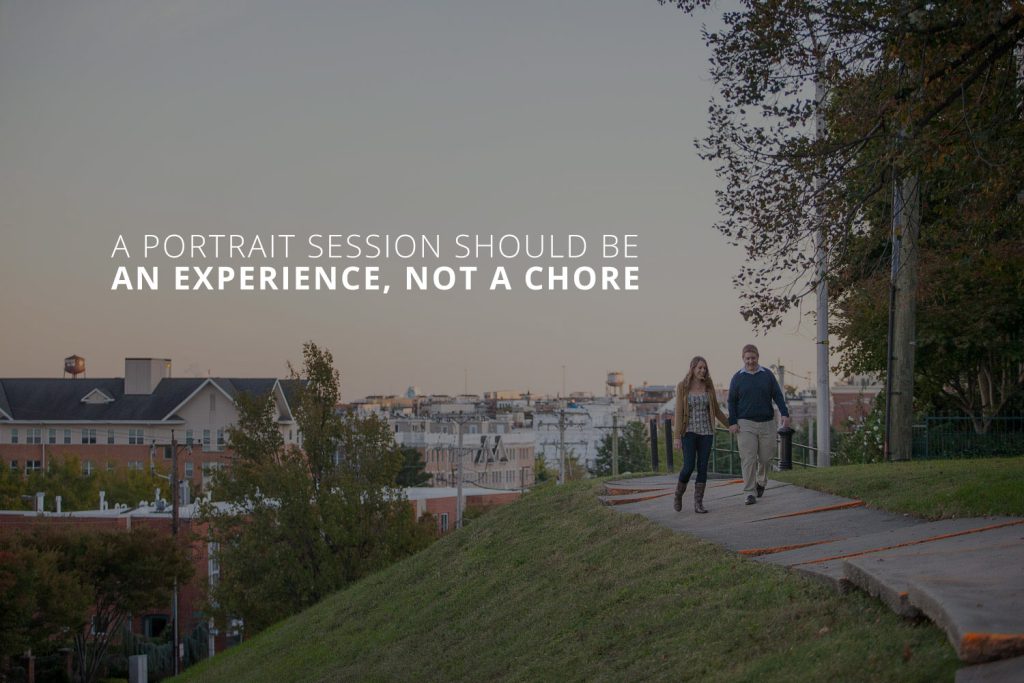If you ask just about any portrait photographer what kind of person they like to work with, the vast majority of their answers will include something along the lines of “a person who wants to be there”. There are a lot of good reasons for this response. Perhaps most obviously, it’s usually a lot more fun to work with you when you’re willing. But, more importantly, the images are almost always better. Photographers will go to surprising lengths to get a better image, sometimes risking life and limb, and at least a good dose of their ego. But it’s worth it, because when it comes down to it, this is what photographers are about.
Every photographer is different, but generally we all want you to have some identifiable level of enthusiasm or “creative daring” to match with when shooting portraits. If you want to be there, you have that. Some subjects are slower paced and more reserved, while still responding positively and engaging with the session. Other clients respond enthusiastically, and are openly excited about the twists and turns a session is taking. In both cases though, there is an unspoken channel of communication between the photographer and their subject that is both informing and helping to fulfill the photographer’s vision for the images.
However, this is very much not the case if you don’t want to be there—If this portrait session is a chore for you, and nothing more than a means to an end. That unspoken channel of communication is closed. You’re following instructions so accurately that you don’t look natural. Your smiles are not genuine. Your pensive faces look pained. When you see previews, you don’t have any opinions. If this session were an artist painting a picture in a studio, you would be the lightbulb, and you’re off. The painter is working in the dark.
Now, it’s more common to find this kind of thing in commercial and headshot sessions than it is in family, engagement and personal sessions. And that makes sense, because businesses and professionals need images, they don’t necessarily want them. But, we see it in those other places too: think angsty teenagers and fiancee’s skipping the wedding hype. It might not be you who doesn’t want to be there, it might be the person you want to be photographed with, or the person you want to have a photograph of.
This is an important enough issue that we’ve shaped significant parts of our shooting style around working with folks like this to help turn them around and get something really good. Although the exact technique is different depending on who we’re working with, the overall solution is pretty much the same. The session needs to be an experience. We need to find out what experience you want to have, and you need to engage that experience.
Children want the experience of playing, so we play. Teenagers usually want to experience being heard and respected, so we listen and give them respect. Adults long for a myriad of experiences (sometimes new experiences, sometimes familiar ones) so we shape the session around an experience that interests them. You should think about a portrait session as an experience, not just something you need to do to get something you want. The more you can appreciate the new experience of working with a photographer, or the more open you can be to adding a photographer to an experience you’re familiar with, the more fun you’ll have and the better the photos will inevitably turn out.
If you’re excited about the session, but someone else is definitively not excited, do this: Find out what experience they want to have, and then find a compromise that will win their support. For example, maybe they’ve been wanting to go to a vineyard. So lets hold the session at the vineyard.
Take teenagers ideas seriously, and make an effort to incorporate some of them, teenagers need to feel like their part of this, and not just getting dragged along. Remember, kids don’t do compromise well. “Compromising” on going out for ice cream after the shoot is not going to win a kid’s support while actually shooting. They need to be in support of what is happening practically minute by minute.
If you’re getting pushback from your employees or team about getting some headshots made, try to find out what experience they’re trying to avoid. Maybe they hate being under the studio lights—it reminds them of middle school picture day. Maybe they hate being the center of attention. Whatever it is, we can bend the session to avoid that experience. Better yet, find an experience your team would like to share—that could even just be a company picnic or something along those lines—and make room in there for some headshots off to the side.
We’ve been designing sessions and working with people like you for a very long time, and our clients almost always leave their session with more enthusiasm than they had when they arrived. If you’re interested in learning more about our portrait sessions, and headshot services, we’d love to hear from you. Get in touch with us today!

